Incentive Plan Strategies for Blue Collar Workforce Evaluation
VerifiedAdded on 2022/08/22
|6
|1259
|17
Homework Assignment
AI Summary
This assignment provides a comprehensive analysis of incentive plans specifically designed for the blue-collar workforce. It begins with an introduction to incentive and reward systems, emphasizing their role in recognizing employee performance, and distinguishes between incentive plans for white-collar and blue-collar workers. The assignment details various compensation methods, including fixed pay rates and performance-based pay, with examples like company drivers and vehicle mechanics. It explores the Halsey System and Rowan System, providing formulas and calculations to illustrate how these systems determine incentives based on time saved. The assignment also suggests spot awards, point systems, and merit pay as effective ways to recognize and reward high-performing blue-collar workers. These methods aim to boost employee morale and job satisfaction. The document concludes with a list of relevant references.
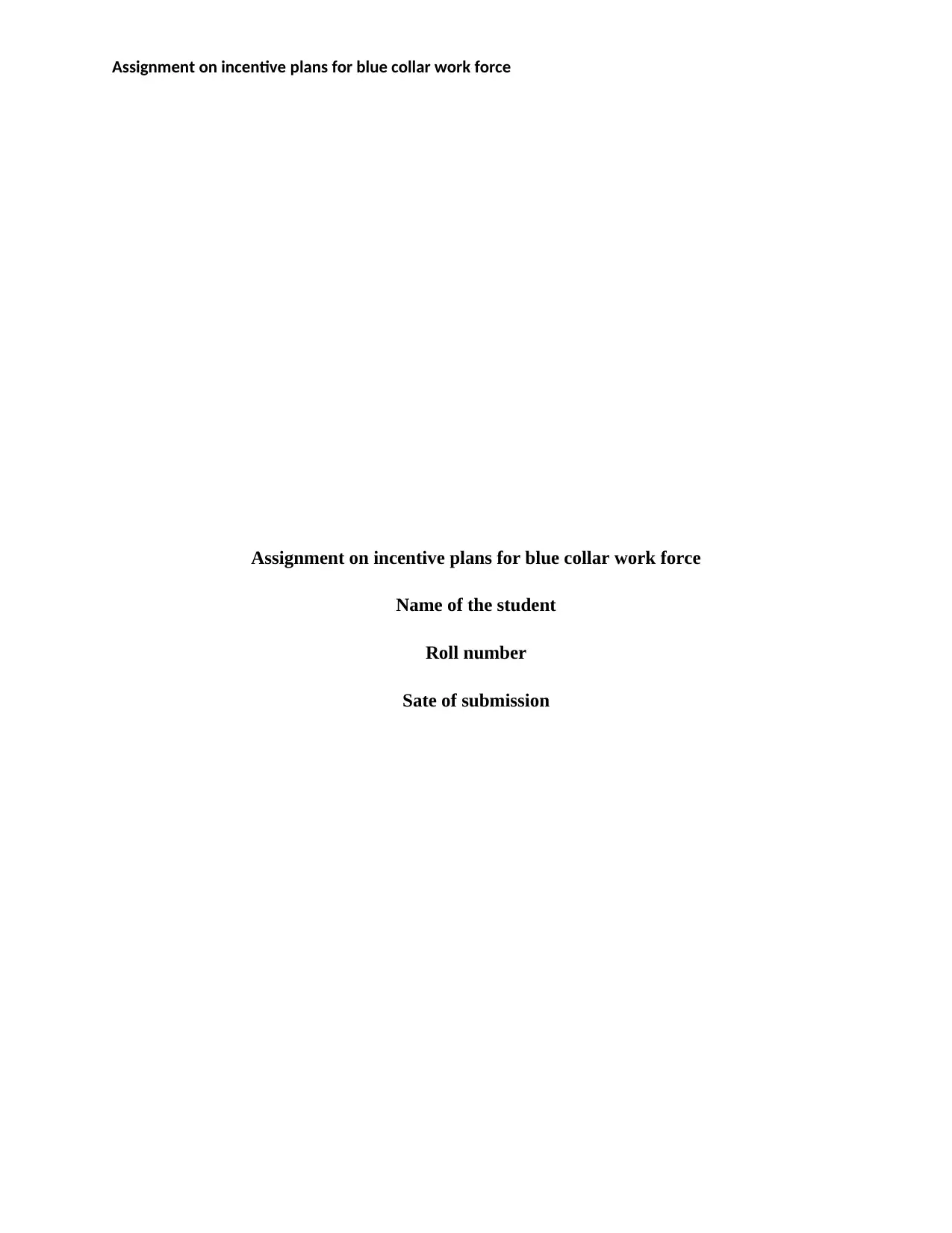
Assignment on incentive plans for blue collar work force
Assignment on incentive plans for blue collar work force
Name of the student
Roll number
Sate of submission
Assignment on incentive plans for blue collar work force
Name of the student
Roll number
Sate of submission
Paraphrase This Document
Need a fresh take? Get an instant paraphrase of this document with our AI Paraphraser
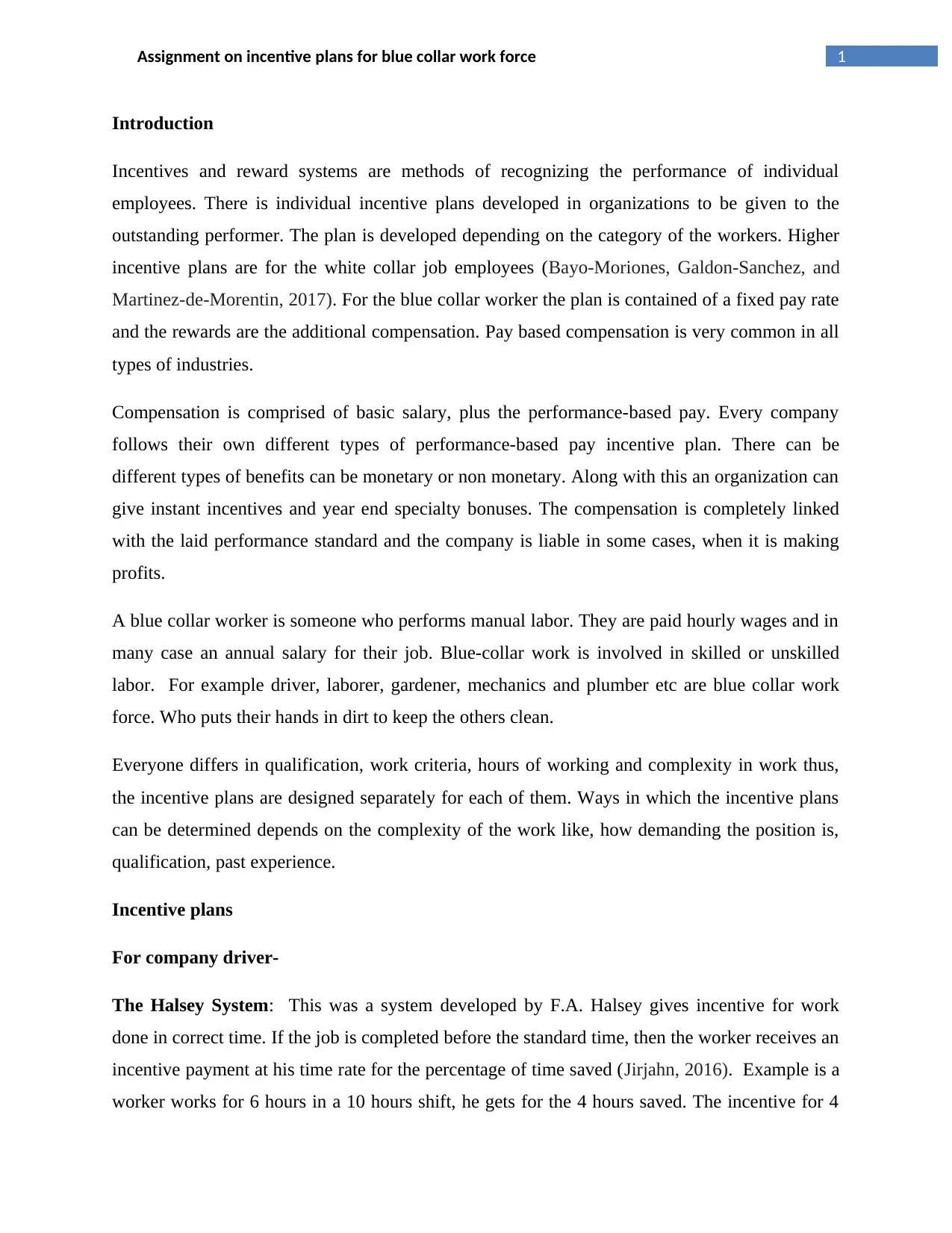
1Assignment on incentive plans for blue collar work force
Introduction
Incentives and reward systems are methods of recognizing the performance of individual
employees. There is individual incentive plans developed in organizations to be given to the
outstanding performer. The plan is developed depending on the category of the workers. Higher
incentive plans are for the white collar job employees (Bayo-Moriones, Galdon-Sanchez, and
Martinez-de-Morentin, 2017). For the blue collar worker the plan is contained of a fixed pay rate
and the rewards are the additional compensation. Pay based compensation is very common in all
types of industries.
Compensation is comprised of basic salary, plus the performance-based pay. Every company
follows their own different types of performance-based pay incentive plan. There can be
different types of benefits can be monetary or non monetary. Along with this an organization can
give instant incentives and year end specialty bonuses. The compensation is completely linked
with the laid performance standard and the company is liable in some cases, when it is making
profits.
A blue collar worker is someone who performs manual labor. They are paid hourly wages and in
many case an annual salary for their job. Blue-collar work is involved in skilled or unskilled
labor. For example driver, laborer, gardener, mechanics and plumber etc are blue collar work
force. Who puts their hands in dirt to keep the others clean.
Everyone differs in qualification, work criteria, hours of working and complexity in work thus,
the incentive plans are designed separately for each of them. Ways in which the incentive plans
can be determined depends on the complexity of the work like, how demanding the position is,
qualification, past experience.
Incentive plans
For company driver-
The Halsey System: This was a system developed by F.A. Halsey gives incentive for work
done in correct time. If the job is completed before the standard time, then the worker receives an
incentive payment at his time rate for the percentage of time saved (Jirjahn, 2016). Example is a
worker works for 6 hours in a 10 hours shift, he gets for the 4 hours saved. The incentive for 4
Introduction
Incentives and reward systems are methods of recognizing the performance of individual
employees. There is individual incentive plans developed in organizations to be given to the
outstanding performer. The plan is developed depending on the category of the workers. Higher
incentive plans are for the white collar job employees (Bayo-Moriones, Galdon-Sanchez, and
Martinez-de-Morentin, 2017). For the blue collar worker the plan is contained of a fixed pay rate
and the rewards are the additional compensation. Pay based compensation is very common in all
types of industries.
Compensation is comprised of basic salary, plus the performance-based pay. Every company
follows their own different types of performance-based pay incentive plan. There can be
different types of benefits can be monetary or non monetary. Along with this an organization can
give instant incentives and year end specialty bonuses. The compensation is completely linked
with the laid performance standard and the company is liable in some cases, when it is making
profits.
A blue collar worker is someone who performs manual labor. They are paid hourly wages and in
many case an annual salary for their job. Blue-collar work is involved in skilled or unskilled
labor. For example driver, laborer, gardener, mechanics and plumber etc are blue collar work
force. Who puts their hands in dirt to keep the others clean.
Everyone differs in qualification, work criteria, hours of working and complexity in work thus,
the incentive plans are designed separately for each of them. Ways in which the incentive plans
can be determined depends on the complexity of the work like, how demanding the position is,
qualification, past experience.
Incentive plans
For company driver-
The Halsey System: This was a system developed by F.A. Halsey gives incentive for work
done in correct time. If the job is completed before the standard time, then the worker receives an
incentive payment at his time rate for the percentage of time saved (Jirjahn, 2016). Example is a
worker works for 6 hours in a 10 hours shift, he gets for the 4 hours saved. The incentive for 4
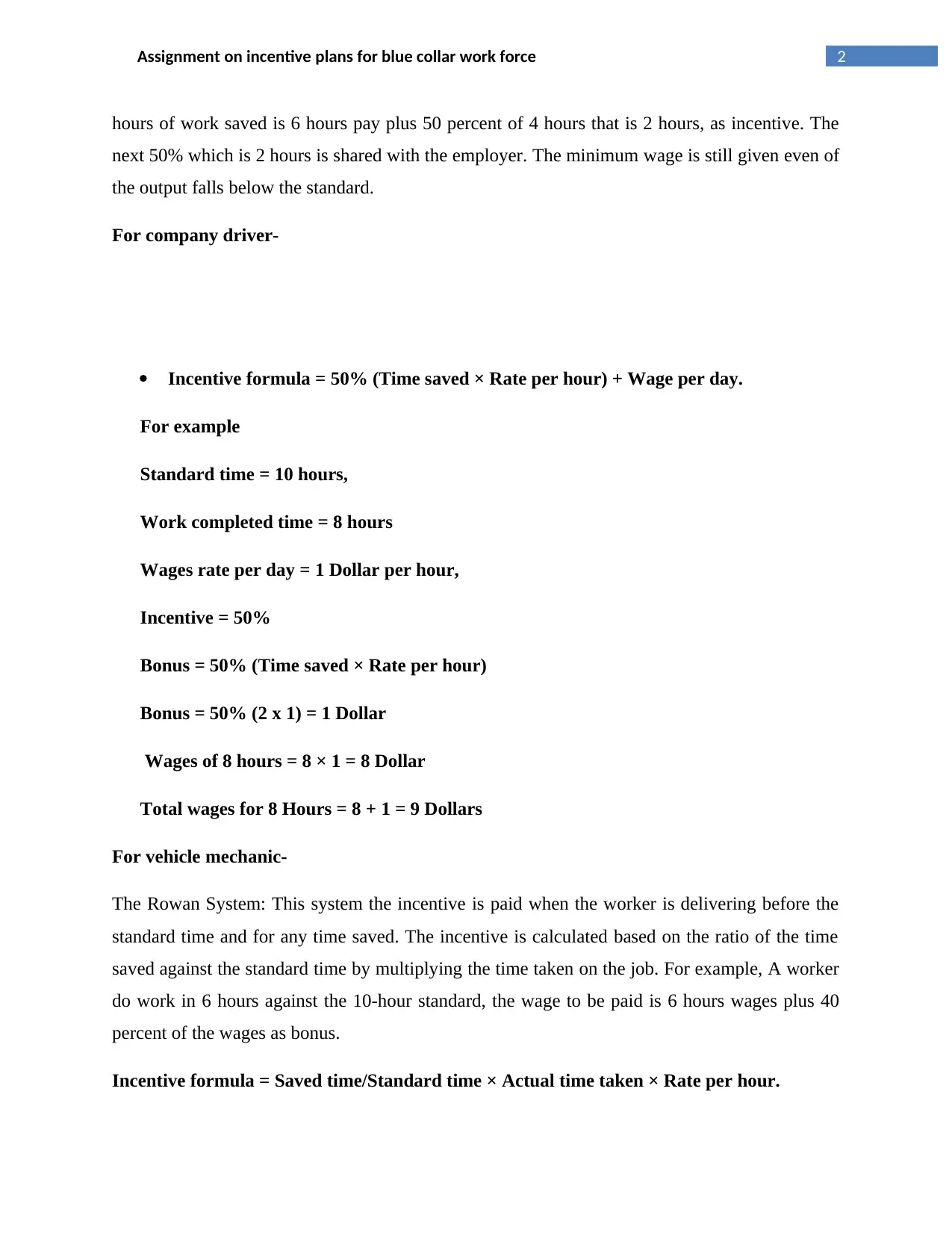
2Assignment on incentive plans for blue collar work force
hours of work saved is 6 hours pay plus 50 percent of 4 hours that is 2 hours, as incentive. The
next 50% which is 2 hours is shared with the employer. The minimum wage is still given even of
the output falls below the standard.
For company driver-
Incentive formula = 50% (Time saved × Rate per hour) + Wage per day.
For example
Standard time = 10 hours,
Work completed time = 8 hours
Wages rate per day = 1 Dollar per hour,
Incentive = 50%
Bonus = 50% (Time saved × Rate per hour)
Bonus = 50% (2 x 1) = 1 Dollar
Wages of 8 hours = 8 × 1 = 8 Dollar
Total wages for 8 Hours = 8 + 1 = 9 Dollars
For vehicle mechanic-
The Rowan System: This system the incentive is paid when the worker is delivering before the
standard time and for any time saved. The incentive is calculated based on the ratio of the time
saved against the standard time by multiplying the time taken on the job. For example, A worker
do work in 6 hours against the 10-hour standard, the wage to be paid is 6 hours wages plus 40
percent of the wages as bonus.
Incentive formula = Saved time/Standard time × Actual time taken × Rate per hour.
hours of work saved is 6 hours pay plus 50 percent of 4 hours that is 2 hours, as incentive. The
next 50% which is 2 hours is shared with the employer. The minimum wage is still given even of
the output falls below the standard.
For company driver-
Incentive formula = 50% (Time saved × Rate per hour) + Wage per day.
For example
Standard time = 10 hours,
Work completed time = 8 hours
Wages rate per day = 1 Dollar per hour,
Incentive = 50%
Bonus = 50% (Time saved × Rate per hour)
Bonus = 50% (2 x 1) = 1 Dollar
Wages of 8 hours = 8 × 1 = 8 Dollar
Total wages for 8 Hours = 8 + 1 = 9 Dollars
For vehicle mechanic-
The Rowan System: This system the incentive is paid when the worker is delivering before the
standard time and for any time saved. The incentive is calculated based on the ratio of the time
saved against the standard time by multiplying the time taken on the job. For example, A worker
do work in 6 hours against the 10-hour standard, the wage to be paid is 6 hours wages plus 40
percent of the wages as bonus.
Incentive formula = Saved time/Standard time × Actual time taken × Rate per hour.
⊘ This is a preview!⊘
Do you want full access?
Subscribe today to unlock all pages.

Trusted by 1+ million students worldwide
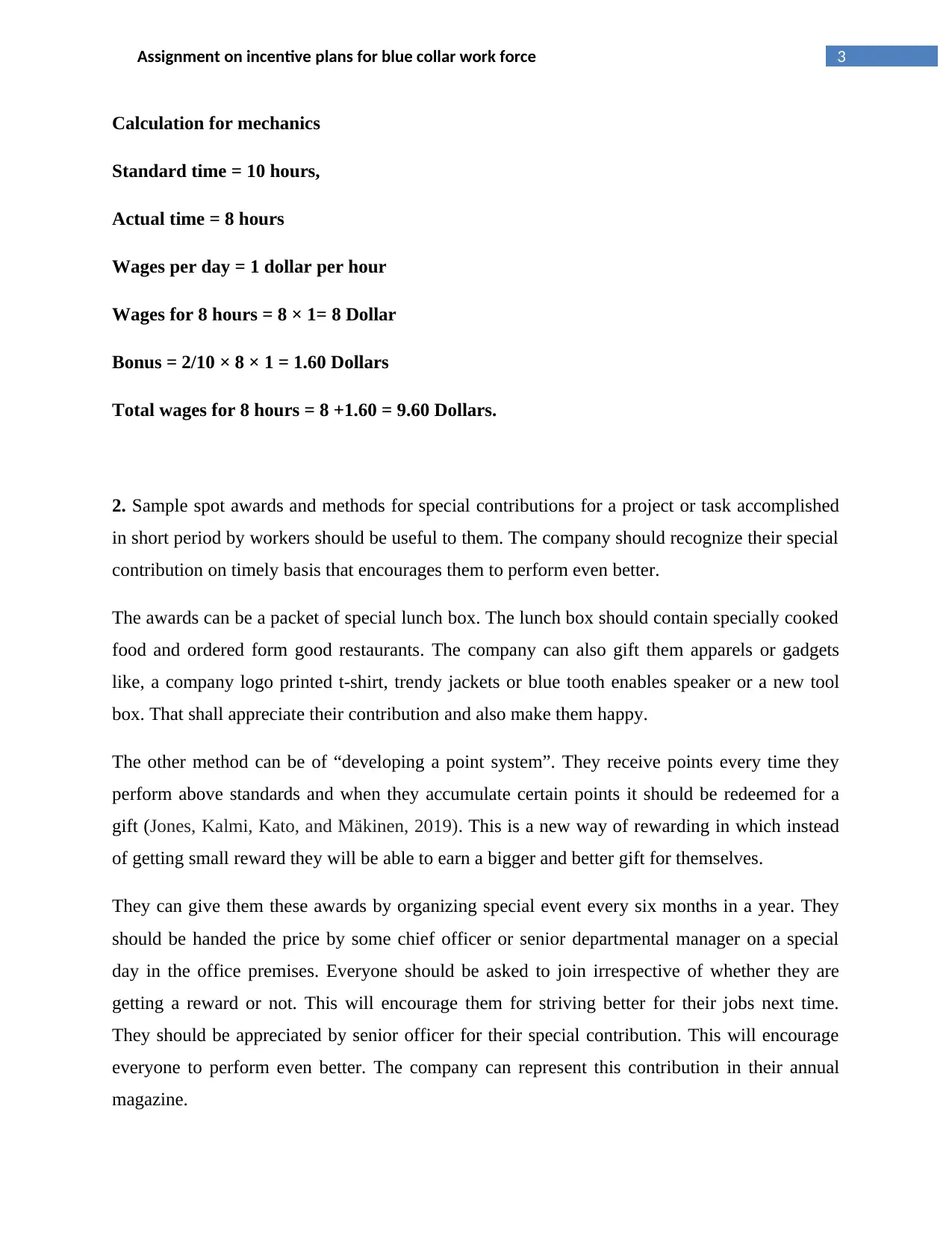
3Assignment on incentive plans for blue collar work force
Calculation for mechanics
Standard time = 10 hours,
Actual time = 8 hours
Wages per day = 1 dollar per hour
Wages for 8 hours = 8 × 1= 8 Dollar
Bonus = 2/10 × 8 × 1 = 1.60 Dollars
Total wages for 8 hours = 8 +1.60 = 9.60 Dollars.
2. Sample spot awards and methods for special contributions for a project or task accomplished
in short period by workers should be useful to them. The company should recognize their special
contribution on timely basis that encourages them to perform even better.
The awards can be a packet of special lunch box. The lunch box should contain specially cooked
food and ordered form good restaurants. The company can also gift them apparels or gadgets
like, a company logo printed t-shirt, trendy jackets or blue tooth enables speaker or a new tool
box. That shall appreciate their contribution and also make them happy.
The other method can be of “developing a point system”. They receive points every time they
perform above standards and when they accumulate certain points it should be redeemed for a
gift (Jones, Kalmi, Kato, and Mäkinen, 2019). This is a new way of rewarding in which instead
of getting small reward they will be able to earn a bigger and better gift for themselves.
They can give them these awards by organizing special event every six months in a year. They
should be handed the price by some chief officer or senior departmental manager on a special
day in the office premises. Everyone should be asked to join irrespective of whether they are
getting a reward or not. This will encourage them for striving better for their jobs next time.
They should be appreciated by senior officer for their special contribution. This will encourage
everyone to perform even better. The company can represent this contribution in their annual
magazine.
Calculation for mechanics
Standard time = 10 hours,
Actual time = 8 hours
Wages per day = 1 dollar per hour
Wages for 8 hours = 8 × 1= 8 Dollar
Bonus = 2/10 × 8 × 1 = 1.60 Dollars
Total wages for 8 hours = 8 +1.60 = 9.60 Dollars.
2. Sample spot awards and methods for special contributions for a project or task accomplished
in short period by workers should be useful to them. The company should recognize their special
contribution on timely basis that encourages them to perform even better.
The awards can be a packet of special lunch box. The lunch box should contain specially cooked
food and ordered form good restaurants. The company can also gift them apparels or gadgets
like, a company logo printed t-shirt, trendy jackets or blue tooth enables speaker or a new tool
box. That shall appreciate their contribution and also make them happy.
The other method can be of “developing a point system”. They receive points every time they
perform above standards and when they accumulate certain points it should be redeemed for a
gift (Jones, Kalmi, Kato, and Mäkinen, 2019). This is a new way of rewarding in which instead
of getting small reward they will be able to earn a bigger and better gift for themselves.
They can give them these awards by organizing special event every six months in a year. They
should be handed the price by some chief officer or senior departmental manager on a special
day in the office premises. Everyone should be asked to join irrespective of whether they are
getting a reward or not. This will encourage them for striving better for their jobs next time.
They should be appreciated by senior officer for their special contribution. This will encourage
everyone to perform even better. The company can represent this contribution in their annual
magazine.
Paraphrase This Document
Need a fresh take? Get an instant paraphrase of this document with our AI Paraphraser
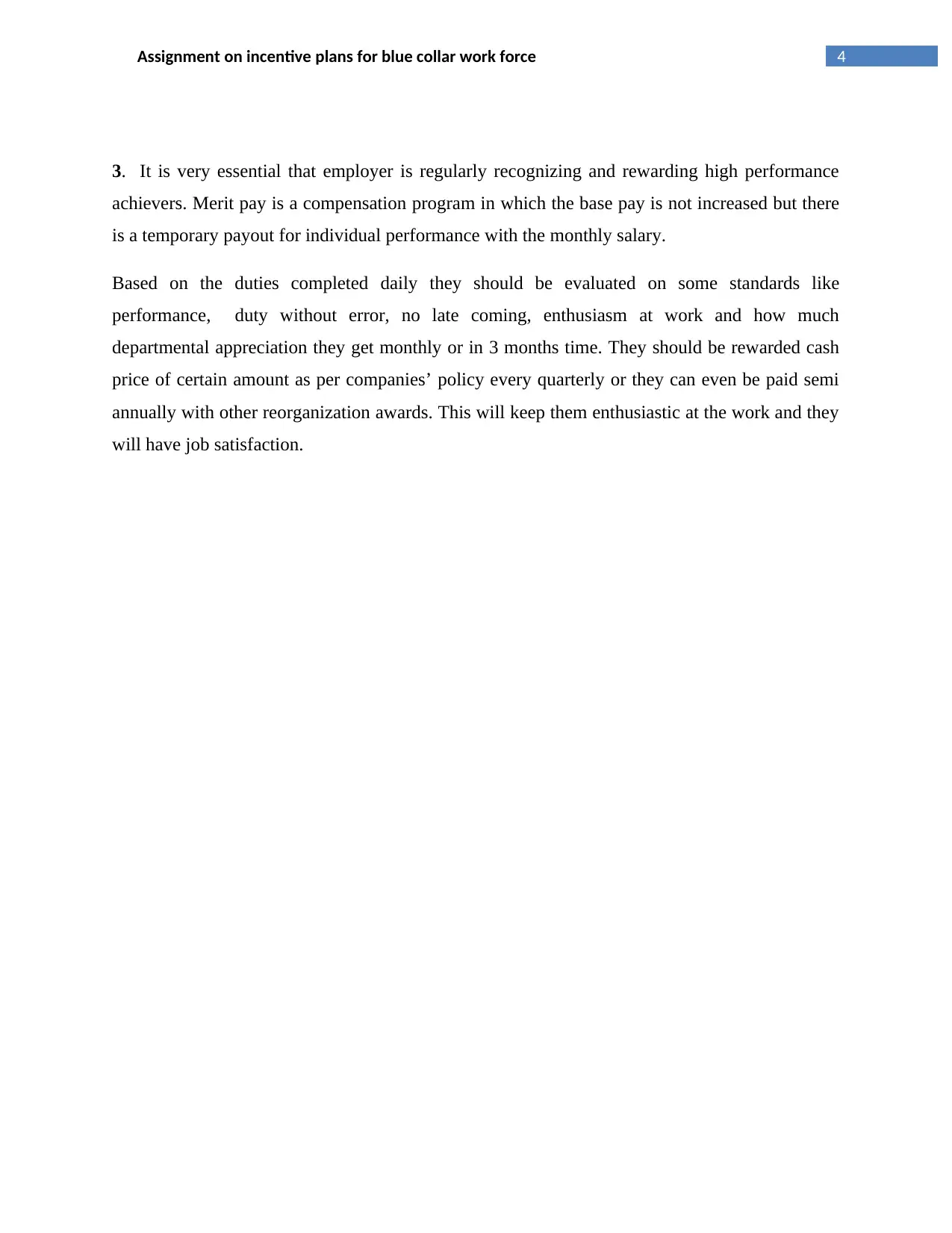
4Assignment on incentive plans for blue collar work force
3. It is very essential that employer is regularly recognizing and rewarding high performance
achievers. Merit pay is a compensation program in which the base pay is not increased but there
is a temporary payout for individual performance with the monthly salary.
Based on the duties completed daily they should be evaluated on some standards like
performance, duty without error, no late coming, enthusiasm at work and how much
departmental appreciation they get monthly or in 3 months time. They should be rewarded cash
price of certain amount as per companies’ policy every quarterly or they can even be paid semi
annually with other reorganization awards. This will keep them enthusiastic at the work and they
will have job satisfaction.
3. It is very essential that employer is regularly recognizing and rewarding high performance
achievers. Merit pay is a compensation program in which the base pay is not increased but there
is a temporary payout for individual performance with the monthly salary.
Based on the duties completed daily they should be evaluated on some standards like
performance, duty without error, no late coming, enthusiasm at work and how much
departmental appreciation they get monthly or in 3 months time. They should be rewarded cash
price of certain amount as per companies’ policy every quarterly or they can even be paid semi
annually with other reorganization awards. This will keep them enthusiastic at the work and they
will have job satisfaction.
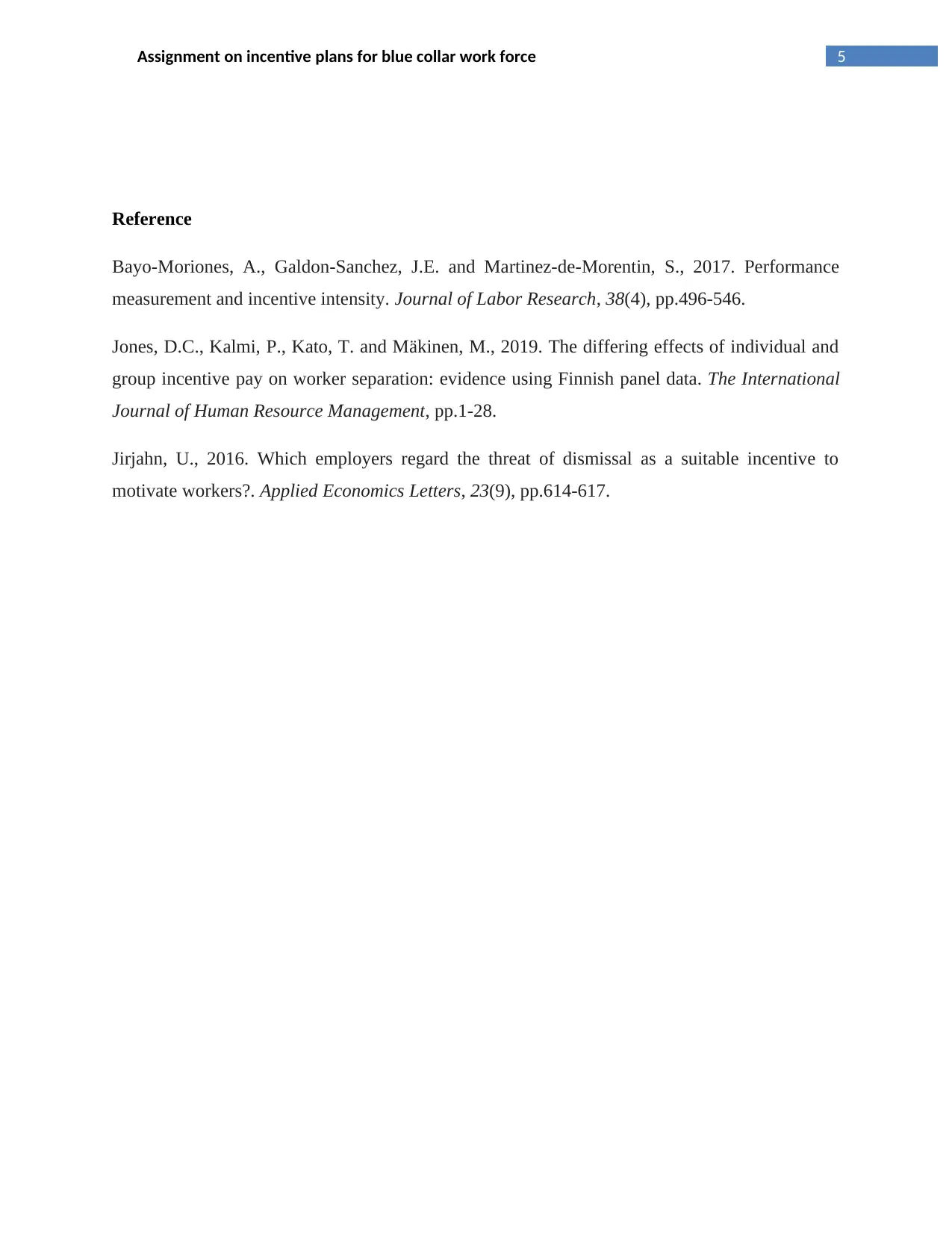
5Assignment on incentive plans for blue collar work force
Reference
Bayo-Moriones, A., Galdon-Sanchez, J.E. and Martinez-de-Morentin, S., 2017. Performance
measurement and incentive intensity. Journal of Labor Research, 38(4), pp.496-546.
Jones, D.C., Kalmi, P., Kato, T. and Mäkinen, M., 2019. The differing effects of individual and
group incentive pay on worker separation: evidence using Finnish panel data. The International
Journal of Human Resource Management, pp.1-28.
Jirjahn, U., 2016. Which employers regard the threat of dismissal as a suitable incentive to
motivate workers?. Applied Economics Letters, 23(9), pp.614-617.
Reference
Bayo-Moriones, A., Galdon-Sanchez, J.E. and Martinez-de-Morentin, S., 2017. Performance
measurement and incentive intensity. Journal of Labor Research, 38(4), pp.496-546.
Jones, D.C., Kalmi, P., Kato, T. and Mäkinen, M., 2019. The differing effects of individual and
group incentive pay on worker separation: evidence using Finnish panel data. The International
Journal of Human Resource Management, pp.1-28.
Jirjahn, U., 2016. Which employers regard the threat of dismissal as a suitable incentive to
motivate workers?. Applied Economics Letters, 23(9), pp.614-617.
⊘ This is a preview!⊘
Do you want full access?
Subscribe today to unlock all pages.

Trusted by 1+ million students worldwide
1 out of 6
Related Documents
Your All-in-One AI-Powered Toolkit for Academic Success.
+13062052269
info@desklib.com
Available 24*7 on WhatsApp / Email
![[object Object]](/_next/static/media/star-bottom.7253800d.svg)
Unlock your academic potential
Copyright © 2020–2025 A2Z Services. All Rights Reserved. Developed and managed by ZUCOL.





